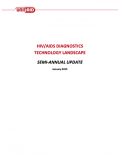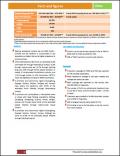Publications on People Living With HIV (PLHIV)

Resource | Publications,
The United States National Institutes of Health-funded international randomized clinical trial START (Strategic Timing of Antiretroviral Treatment) has found compelling evidence that the benefits of starting antiretroviral therapy as soon as someone is diagnosed outweigh the risks of delaying.

Resource | Publications,
The HIV/AIDS Diagnostics Technology Landscape is published annually and is prepared as part of a broad and ongoing effort to understand the technology landscape for HIV/AIDS. This document os a semi-annual update on the point-of-care technologies for CD4, viral load, and early infant diagnosis (EID) testing, as well as for the diagnostic pipeline.

Resource | Publications,
Started in 2005, the Thailand Ministry of Public Heath by Bureau of AIDS and STI, the A2 Thailand and the Thai Working Group on HIV/AIDS Projections (2005) presented the HIV projection for HIV/AIDS in Thailand 2005-2025 using the Asian Epidemic Model. The results had been used to guide the National Strategic Plan.

Resource | Fact Sheets,
Of the estimated 810 000 PLHIV, an estimated 46.9% contracted HIV through heterosexual contact, 20.3% through male‐to‐male sex, 25.7% through injecting drug use, 6.0% through former plasma donation or receipt of contaminated blood/blood products, and 1.1% through mother to child transmission (MTCT). There are significant increases in MSM transmission.

Resource | Guidelines,
This update will both augment and complement the 2011 Myanmar Guidelines published by the National AIDS Programme. In Myanmar, a country with limited resources and capacity, the available resources must be best employed to achieve the best possible solutions for People Living with HIV. With this in mind, evidence based recommendations have also been made in PMTCT; PEP and coinfection with HBV and HCV.

Resource | Publications,
The Annual Report 2013-2014 of the Department of AIDS Control (DAC), Government of India, reviews the progress made under the National AIDS Control Programme (NACP) during the current financial year 2013-2014 in scaling up intervention services for HIV prevention, treatment, care and support across the country through regular monitoring and reporting.

Resource | Reviews and Snapshots,
By 2020, 90% of all people living with HIV will know their HIV status. By 2020, 90% of all people with diagnosed HIV infection will receive sustained antiretroviral therapy. By 2020, 90% of all people receiving antiretroviral therapy will have durable viral suppression.








